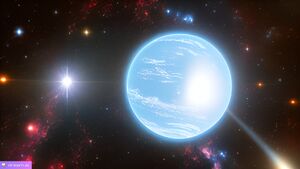
Lestra is a star not far from Markab, only around 16 ly from that system and around 120 ly from Earth, the terrestrial stellar catalogue lists it as HD 218133. It is a G0 star brighter and hotter than Sol but still well within optimal range for M class planets. The star has a faster spin than most G type stars leaving a higher incidence of radiation bursts as the magnetic field moves along the plane of the system.
The system has 14 planets. The closest 7 are rocky planets with the remaining 6 to be gas giants of various kinds. There are 3 M class planets, the closest being Lestra 2 which is a desert planet. It supports a very sparse population centered around a stellar observatory from the Vulcan Science Academy in a joint effort with the Tellarite Exploration Directorate.
Lestra Prime / Lestra 2
Uninhabitable rocks with no atmosphere, both sitting so close to their sun that life having ever existed there is not possible. Lestra Prime has the oddity of a very rapid rotational velocity on a very steep axis. Its orbit also closely parallels Lestra 3 and 5 in relative position with their sun. It is made of iron, nickel, and titanium in a partially liquid state, the magnetic field and its high rotational velocity deflects a high percentage of dangerous radiation coming from the sun. Without this barrier it is possible that Lestra 2 would be the only M class planet in the system.
Lestra 3
is almost entirely a water world, evidence suggests that this planet was more Earth-like in its past but that it entered a natural warming period as solar radiation increased causing its once solid ice caps to melt. At present the planet is 98% covered by ocean with sparse island groups spread evenly over its surface. There is a very small population in the main island group on the planet, having been colonized by the Federation in the early 2200's. An automated deuterium refinery at the northern pole is also operated by the Federation with a corresponding landing platform in orbit above the facility. Other than that this planet leaves little to offer except in its nearly year round tropical climate. The ruling council is friendly toward those wishing to vacation their but provides little in the way of incentive, there are no hotels, resorts, or modern commerce on the planet.
Lestra 4
This world has an extremely dense and toxic atmosphere, very similar to the planet Venus in the Sol system. In the early 2200's much research was done here looking for evidence of an industrial civilization that perhaps went awry but none was ever found. There are valuable minerals on the planet but mining operations there have been deemed too resource intensive at present to support a mining operation.
Lestra 5
An M class planet. Much more Earth-like it was turned into a nature reserve by the Federation Council some 125 years ago. Endangered species that fit into the planets ecology were placed there at the time. A handful of scientific research facilities monitor the population of its species very carefully. Landing there is not permitted without advanced authorization. Though that authorization is not hard to come by. Naturists frequently visit the scientific facilities mostly for research purposes but tourism is allowed with prior permission. Those visiting are not allowed beyond the small research facilities, even air and sea travel are restricted.
Outer Planets
On the outermost planets some exotic gas collection operations continue with small space stations that also serve as a more colorful port-of-call, there is a small Federation presence but no more than one or two science ships at a time.